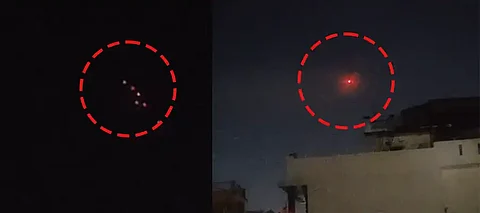

In an intense sequence of events late Thursday night, Pakistan attempted its second consecutive drone and missile attack on Indian soil, specifically targeting Jalandhar and its surroundings. The attack, which started around 9 PM, was met with an iron-clad response by India’s defense systems, particularly the advanced Indrajal anti-drone network, referred to on the ground as the ‘Sudarshan Chakra.’
9:10 PM: Blackout orders were issued for Jalandhar. Power grids across the city were strategically shut down.
9:22 PM: Dawn-style drone flashes appeared over Nakodar Road, Kapurthala Road, and areas surrounding the PAP (Punjab Armed Police) campus.
9:30 PM: Railways responded quickly by switching off lights on moving and stationed trains to maintain camouflage.
10:00 PM: Bright flashes resembling snowfall appeared in the sky. Residents of Baba Mohan Das Nagar and Maqsoodan filmed what appeared to be suicide drones being intercepted.
10:15 PM: DC’s Public Relations team issued a statement confirming that it was part of a large-scale defense operation, not a random attack. Citizens were assured of the Army’s dominance in neutralizing aerial threats.
10:53 PM: Orders were released to shut all schools—government and private—in Jalandhar for two days.
11:20 PM: DC confirmed that all drones involved in the attack had been neutralized by Indrajal defense systems.
12:17 AM: Electricity across Jalandhar remained suspended until emergency service feeders were reactivated around 12:30 AM.
12:47 AM: Power restoration orders were issued; the blackout officially ended in phases.
As explosions rang out in the sky, most civilians adhered to blackout protocols. No sirens were used to avoid panic. Key civilian areas, especially those near Mand village (near Kartarpur), Suranussi, Liddo, and Verka Milk Plant, reported seeing bright intercept flashes in the sky.
Markets shut abruptly. Roads saw heavy movement towards safer areas. National highways saw disciplined but hurried evacuation patterns. The district administration ensured silence and discretion throughout the operation.
Despite pitch darkness outside hospitals like Civil Hospital Jalandhar, medical teams operated uninterrupted inside, with 24/7 ambulance services on standby. Emergency medical supplies were pre-stocked at trauma centers.
At Jalandhar City Railway Station, chaos unfolded post-midnight as migrant workers, many planning their return post-payday, attempted to board trains amidst confusion and fear. However, stories of solidarity surfaced too: one auto driver refused fare from a soldier, saying, “Jai Hind, you are our pride.”
Guru Nanak Chowk, a usually vibrant intersection, stood in complete darkness as a mark of unity.
Meanwhile, village sarpanches were ordered to manually disable solar lights—many of which do not have switches—by wrapping them in plastic or cloth. Any non-compliance would lead to strict administrative action.
Dubbed “Operation Sindoor,” this coordinated Indian defense strategy successfully repelled over 15 drone incursions within 56 minutes. The clear target: security establishments, not civilian areas.
The defense response saw zero civilian casualties. No airstrikes were needed as the drones were intercepted before reaching populated zones. Train and bus services, though running in darkness, remained unaffected.
Essential supplies: No shortages reported. Authorities warned against hoarding.
Public transport: Functional; trains operated with lights off.
Flight operations: Suspended from Adampur Civil Airport till further notice.
Petrol stations: Remained operational throughout.
Civic advisories: Citizens advised to cover automatic lights and turn off decorative LEDs.
This failed aggression marks a turning point in India's regional preparedness. The blackout was not merely a drill but a real-time rehearsal of national defense coordination. The threat was neutralized decisively with civilian cooperation, cutting-edge anti-drone tech, and swift administrative response.